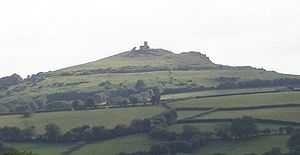Brent Tor


Brent Tor is a tor on the western edge of Dartmoor, approximately five miles (8 km) north of Tavistock, rising to 1100 ft (330m) above sea level. The Tor is surmounted by the Church of St Michael, the parish church of the village of Brentor, which lies below the Tor.
Geology
Brent Tor is a unique example of an early Carboniferous basaltic volcano, now weathered down.[1] It is composed of volcanic breccia and pillow lava exuded beneath a former sea.[2]
History
Around the Tor are Iron Age earthworks, the remnants of a Hill fort.[3] Unusually, the fortifications are at the base of the Tor, rather than the summit as is more normal (compare with Brent Knoll in Somerset). No serious archaeological work has been carried out on the site. However, the northern ramparts in particular are well preserved, displaying a multi-vallate pattern characteristic of the Iron-A, or early -B, culture. There are three distinct consecutive ramparts in this sector, and traces of internal partitioning.

The Church of St Michel de Rupe ("Saint Michael of the Rock") atop the Tor dates to the 13th century, and measures 15 feet (4.6 m) wide and 37 feet (11 m) long. The tower is 40 feet (12 m) high[4] and houses five bells.[5] At one point, the Church may have been used as a Beacon tower, used to spread word of enemies seen out to sea (see also Spanish Armada).
The Church has a capacity of approximately forty people. Although there is a newer (19th century) church (Christchurch) in the village, which is used for many services, St Michael's is still used on Christmas Day, Easter Day and for Evensong during the summer. In 1995 the Church was struck by lightning, which caused extensive damage, but this has since been repaired.
Legends
There are many legends surrounding Brent Tor. One of the best-known is that of the Merchant and the Storm. According to this story, an early medieval merchant paid for the church to be completed after nearly being shipwrecked.[6][7] The churchyard was the scene of filming for the BBC TV version of Jamaica Inn.[8]
References
- ↑ Dartmoor National Park Authority, Educational Register of Geological Sites
- ↑ Robert Hesketh, Devon's Geology, an introduction, page 8. Bossiney Books
- ↑ Hopkins, Adam and Witney, Dudley (1995). The Moorlands of England. Key Porter Books. p. 92. ISBN 9781550136050.
- ↑ Brentor Church: A Guide, Church of England publications
- ↑ Dove's Guide for Church Bell Ringers
- ↑ Legendary Dartmoor
- ↑ Sacred texts
- ↑ Williams, Michael (1984) Unknown Devon. St Teath: Bossiney Books; pp. 16-18
Coordinates: 50°36′11″N 4°09′37″W / 50.603138°N 4.160225°W